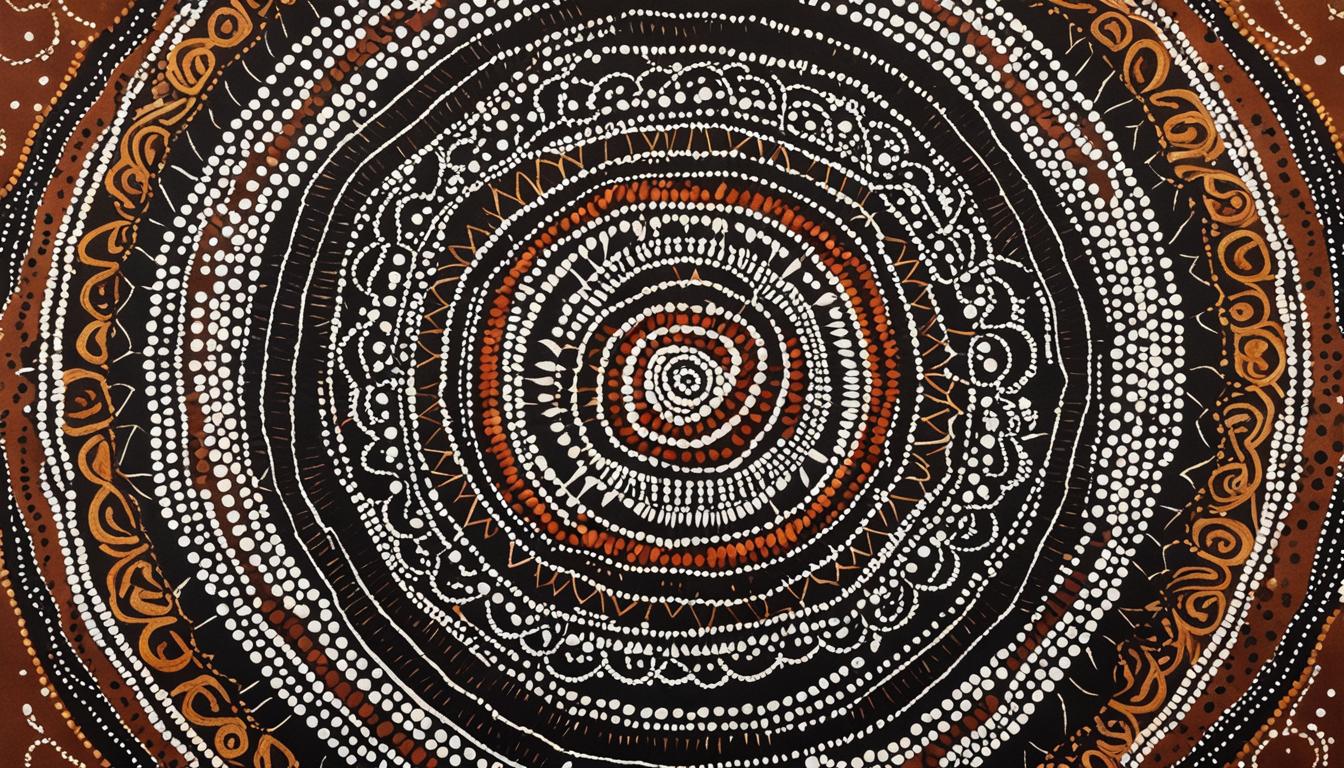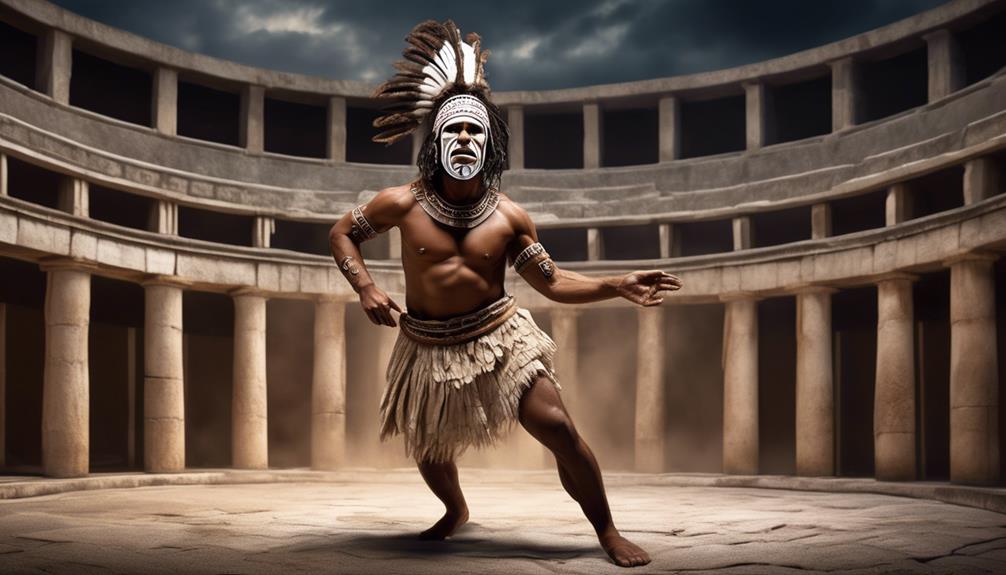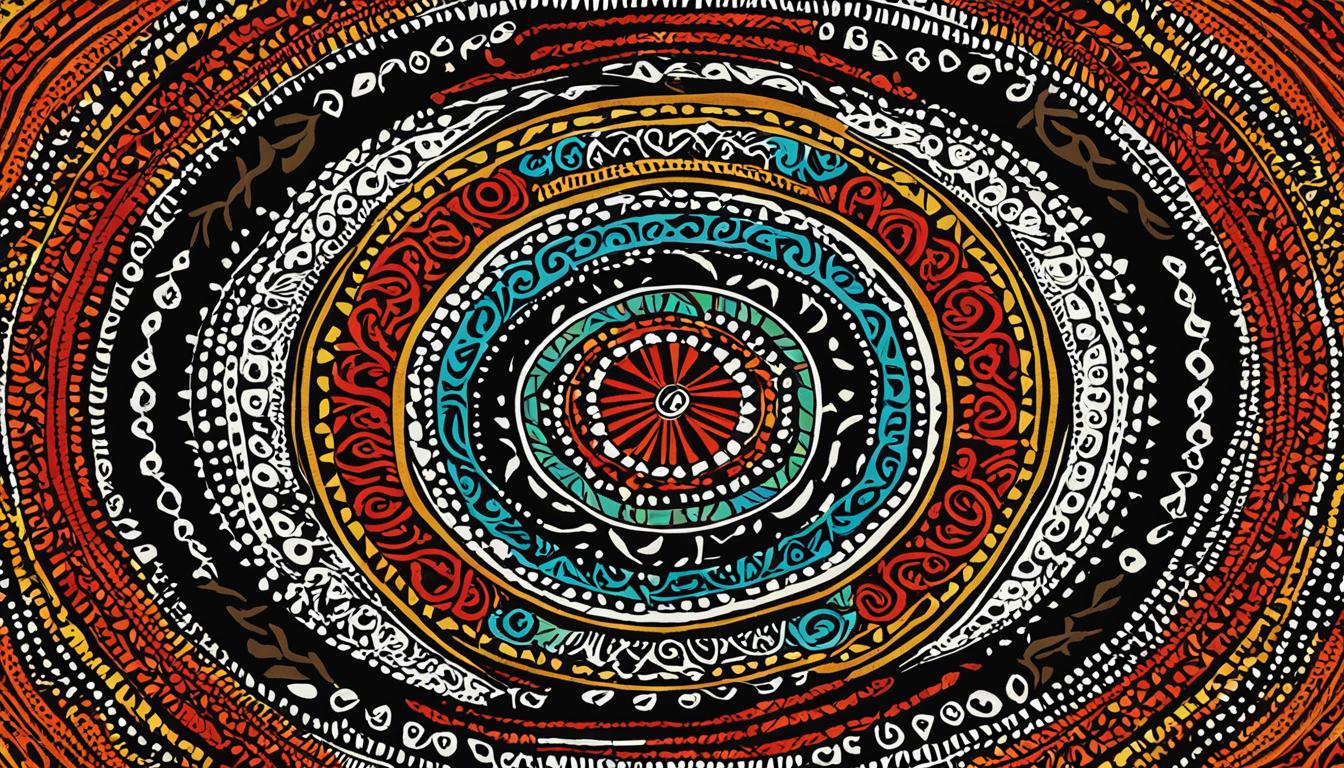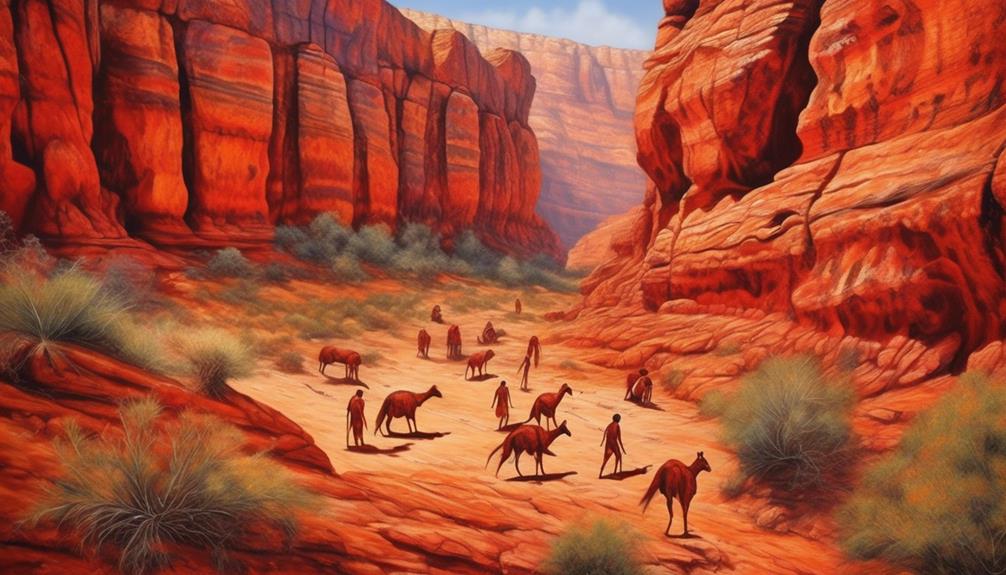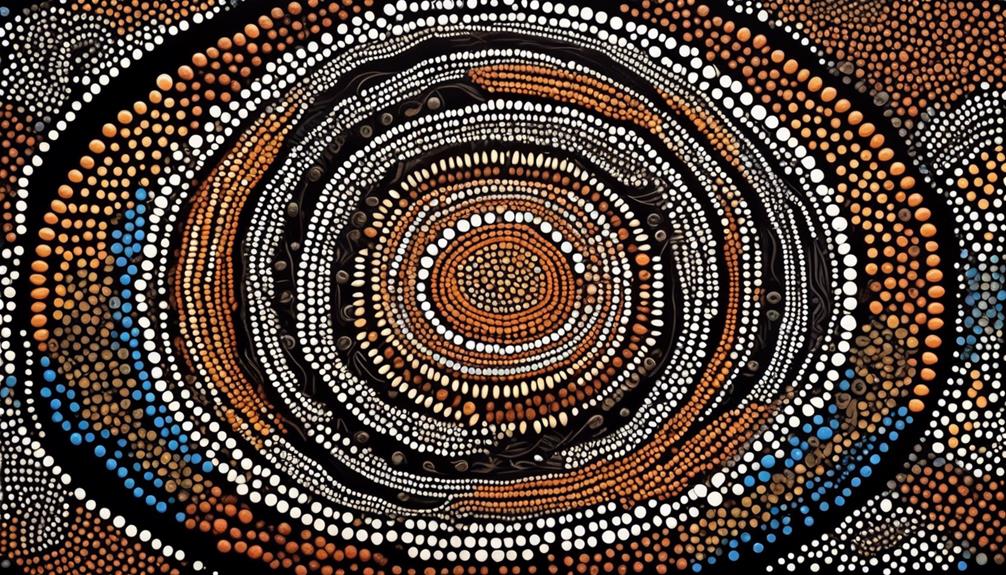Welcome to our series of articles exploring the Indigenous Aboriginal culture in Australia. Throughout this series, we will delve into the rich tapestry of customs, history, art, languages, and spiritual beliefs that form the foundation of Aboriginal culture. By studying the traditions and rituals of Australia’s indigenous peoples, our aim is to foster a deeper understanding and appreciation for their unique culture and way of life.
Aboriginal culture is deeply rooted in the history and traditions of the indigenous people of Australia. It encompasses a rich tapestry of customs, languages, art forms, and spiritual beliefs that have been passed down for generations. To truly understand and appreciate indigenous Aboriginal culture, it is important to delve into its heritage and traditions, as well as the impact of colonization and the ongoing resilience of Aboriginal communities.
Join us as we embark on a journey of discovery, exploring the diverse aspects of Aboriginal culture and gaining insights into their cultural practices, spirituality, and connection to the land. Let’s take this opportunity to deepen our understanding of this ancient and vibrant culture and celebrate the rich diversity that makes Australia so unique.
Key Takeaways:
- Aboriginal culture is a rich tapestry of traditions, languages, art forms, and spiritual beliefs.
- Understanding Aboriginal culture requires an exploration of its heritage and the impact of colonization.
- Aboriginal communities strive to preserve their culture and traditions despite historical challenges.
- Aboriginal culture encompasses a deep spiritual connection to the land.
- Learning about and respecting Aboriginal culture helps build a more inclusive and respectful society.
Aboriginal History
In understanding the cultural competence and deep-rooted connection to Country of Aboriginal people, it is essential to acknowledge the history of colonization and its impact. Before the arrival of Europeans, Aboriginal communities thrived, embracing complex kinship systems, diverse languages, rich cultural practices, and profound knowledge of the environment. However, colonization led to a dark chapter in Aboriginal history, marked by mass killings, forced removal of children, displacement from ancestral lands, cultural suppression, and profound loss. This period saw the establishment of missions, segregation policies, and the devastating consequences of deaths in custody. The struggle for land rights and the ongoing fight for justice and recognition continue to shape Aboriginal history.
“The impact of colonization on Aboriginal people cannot be understated. Forced removals, massacres, and the erosion of cultural practices have left a lasting scar on our communities. To truly understand and appreciate Aboriginal history, it is crucial to confront these past impacts and work towards a society that acknowledges and respects our cultural heritage.”
To foster cultural competence and bridge the gap created by historical injustices, we must educate ourselves about Aboriginal history. By learning about the past impacts of colonization and its ongoing repercussions, we can develop a deeper understanding of the challenges faced by Aboriginal communities and contribute to a more inclusive and supportive society. It is through recognizing the significance of land rights, addressing systemic issues, and advocating for equal opportunities that we can work towards reconciliation and a brighter future for all Australians.
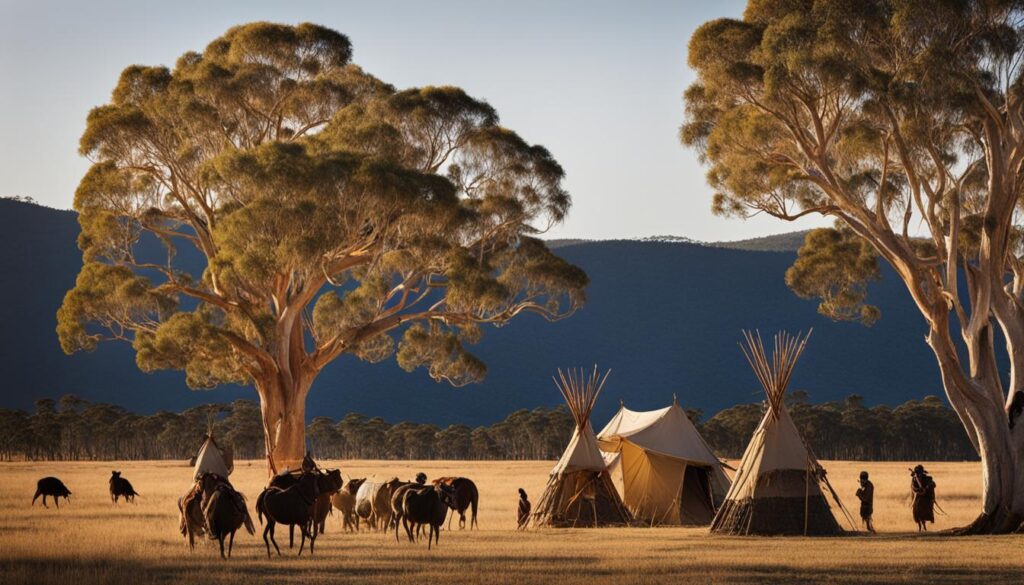
| Key Events and Concepts | Impact |
|---|---|
| Colonization | Mass killings, displacement from ancestral lands, erosion of cultural practices |
| Forced Removals | Breakdown of families, loss of cultural and spiritual connections |
| Missions and Segregation | Suppression of cultural practices, limited access to resources and opportunities |
| Deaths in Custody | Disproportionate incarceration rates, systemic injustice |
| Land Rights | Ongoing struggle for recognition, connection to Country, and self-determination |
Stolen Generations
The Stolen Generations, a dark chapter in Australian history, refers to the Aboriginal and Torres Strait Islander children who were forcibly taken from their families and communities due to government policies. This cruel practice of forced removal had devastating consequences, resulting in the severe disruption of cultural, spiritual, and family ties. The impacts of this traumatic experience continue to reverberate through the generations, affecting the affected individuals as well as their descendants.
By removing children from their families, the government aimed to assimilate them into mainstream society and sever their connection to Aboriginal culture. The consequences were profound, as these children were stripped of their cultural identity, language, and traditional practices. They were denied the opportunity to learn from their elders and to forge meaningful relationships within their own communities.
The inter-generational impact of the Stolen Generations cannot be understated. The forced removal not only caused immense pain and trauma for the individuals directly affected but also had far-reaching consequences for their children, grandchildren, and beyond. The loss of cultural knowledge and the severing of family ties have had lasting effects on the wellbeing and sense of belonging of many Aboriginal communities across Australia.
In 2008, the Australian Prime Minister delivered a momentous National Apology to The Stolen Generations, acknowledging the past wrongs and expressing profound regret for the pain caused. This apology was an important step towards healing and reconciliation, signifying a commitment to redress the injustices inflicted on Aboriginal and Torres Strait Islander people.
“We apologise for the laws and policies of successive parliaments and governments that have inflicted profound grief, suffering, and loss on these our fellow Australians. We apologise especially for the removal of Aboriginal and Torres Strait Islander children from their families, their communities, and their country.”
This National Apology marked a significant milestone in the journey towards acknowledging the injustices of the past and working towards a more inclusive future. It served as a catalyst for dialogue, understanding, and support for the healing and empowerment of the Stolen Generations and their descendants.
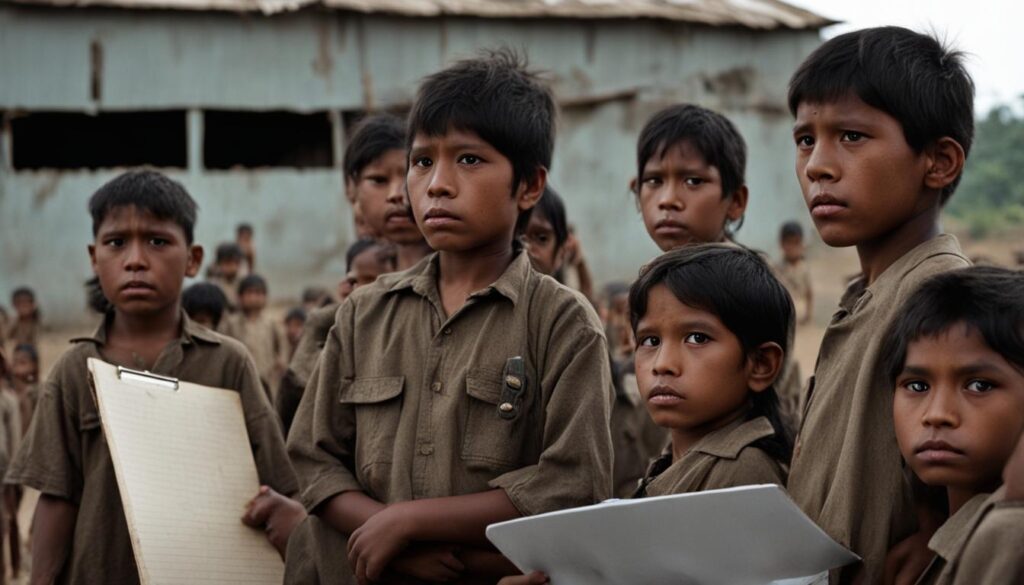
Aboriginal Cultural Connections
Aboriginal culture is deeply rooted in our connections to family, community, and Country. These connections form the foundation of our identity and play a vital role in preserving and passing on our traditions from one generation to the next.
- Family and Community: In Aboriginal culture, family extends beyond immediate relatives and encompasses a broader sense of kinship and community. Our relationships with extended family members, elders, and community members are integral to our cultural connections.
- Connection to Country: Our deep spiritual connection to the land, known as Country, is a fundamental aspect of Aboriginal cultural identity. We have a profound reverence for the land and understand that it sustains us physically, emotionally, and spiritually.
- Cultural Practices: Aboriginal culture is rich with values, symbols, and cultural practices that are passed down through generations. These practices encompass various forms of expression such as language, ceremonies, storytelling, dance, music, and art.
- Aboriginal Language: Language is an integral part of our cultural connections. Aboriginal languages hold unique knowledge and convey the deep spiritual and cultural significance of our traditions.
- Ceremonies: Ceremonies play a central role in Aboriginal culture, bringing community members together to celebrate, mourn, and pass on cultural knowledge. They are a powerful expression of our identity and spirituality.
- Storytelling: Storytelling is a traditional practice that has been used for thousands of years to convey the wisdom, history, and cultural values of our ancestors. Through storytelling, we preserve our traditions and pass them on to future generations.
- Dance and Music: Dance and music are vibrant forms of cultural expression in Aboriginal communities. They serve as a means of storytelling, celebration, and connection to our ancestors.
- Art: Aboriginal art is a powerful medium for expressing our cultural connections. It encompasses a wide range of styles, including dot painting, bark painting, sculpture, and contemporary art forms. Aboriginal art reflects our spiritual beliefs, ancestral connections, and the diversity of our cultural heritage.
By understanding and appreciating these Aboriginal cultural connections, we can gain a deeper insight into the values, symbols, and practices that shape our identity and contribute to the rich tapestry of Australian culture.
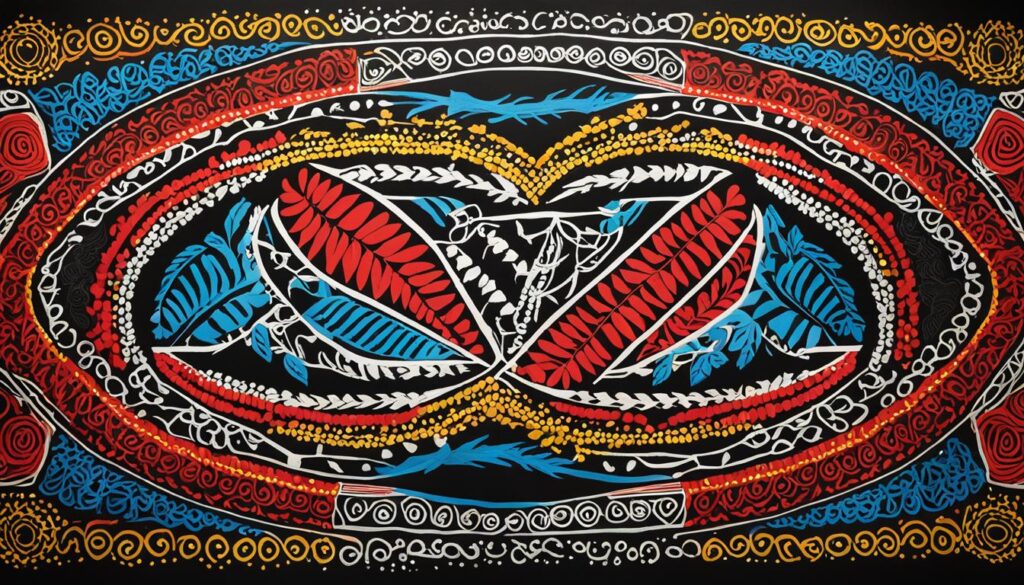
“”Aboriginal Cultural Connections”” Table
| Connection | Description |
|---|---|
| Family and Community | Extended kinship ties and communal relationships |
| Connection to Country | Profound spiritual relationship with the land |
| Cultural Practices | Expressed through language, ceremonies, storytelling, dance, music, and art |
| Aboriginal Language | Integral to cultural identity and knowledge preservation |
| Ceremonies | Central role in community celebrations and cultural transmission |
| Storytelling | Preservation of traditions and ancestral wisdom |
| Dance and Music | Expressions of cultural identity and ancestral connection |
| Art | Visual representation of spiritual beliefs and cultural diversity |
Aboriginal Kinship Ties
Aboriginal culture is deeply rooted in a holistic view that emphasizes the interconnectedness of family, community, land, and spiritual beings. Kinship ties form the foundation of these connections, encompassing relationships based on blood, marriage, association, and spiritual significance. This broad understanding of kinship extends beyond immediate family members and creates a sense of belonging and strong support networks within the community.
In Aboriginal culture, family plays a central role in shaping identity and providing a sense of belonging. It goes beyond nuclear families to include extended family members, creating a web of interconnected relationships that form the building blocks of the community. Each individual has their place within this intricate network, and responsibilities and obligations are shared among family members.
Community and tribe are also fundamental components of Aboriginal kinship ties. The community acts as a support system, providing guidance, mentorship, and a sense of belonging. Tribe refers to larger groups within the community that share a common ancestry and cultural heritage. By belonging to a tribe, individuals strengthen their connections to the land, lore, dreaming, and spiritual significance associated with their ancestral roots.
The relationship between land and kinship is deeply intertwined in Aboriginal culture. Land holds spiritual significance and is seen as the provider of life and sustenance. Aboriginal people have a strong connection to Country, not only as a physical space but as a spiritual and cultural entity. This connection to the land ensures a sense of place, belonging, and a responsibility to care for and protect the environment.
Aboriginal kinship ties form a holistic framework that encompasses family, community, tribe, land, and spiritual significance. They establish a sense of belonging, support, and responsibility within the Aboriginal culture.
Aboriginal kinship ties are deeply rooted in relationships that are both physical and spiritual. Blood ties create strong bonds between individuals, while marriage and association further strengthen connections between families and clans. Spiritual significance adds another layer of depth, recognizing the interconnectedness of all beings and the spiritual essence that resides within each individual.
The understanding of Aboriginal kinship ties and their holistic view shapes the way Aboriginal people navigate their relationships with others and the land. It fosters a deep sense of respect, responsibility, and interconnectedness within the Aboriginal community.
As we explore and learn about Aboriginal kinship ties, we gain a greater appreciation for the complexity and richness of Aboriginal culture. It deepens our understanding of the importance of family, community, land, and spiritual connections, and allows us to cultivate a greater sense of respect and empathy for Aboriginal communities and their unique cultural heritage.
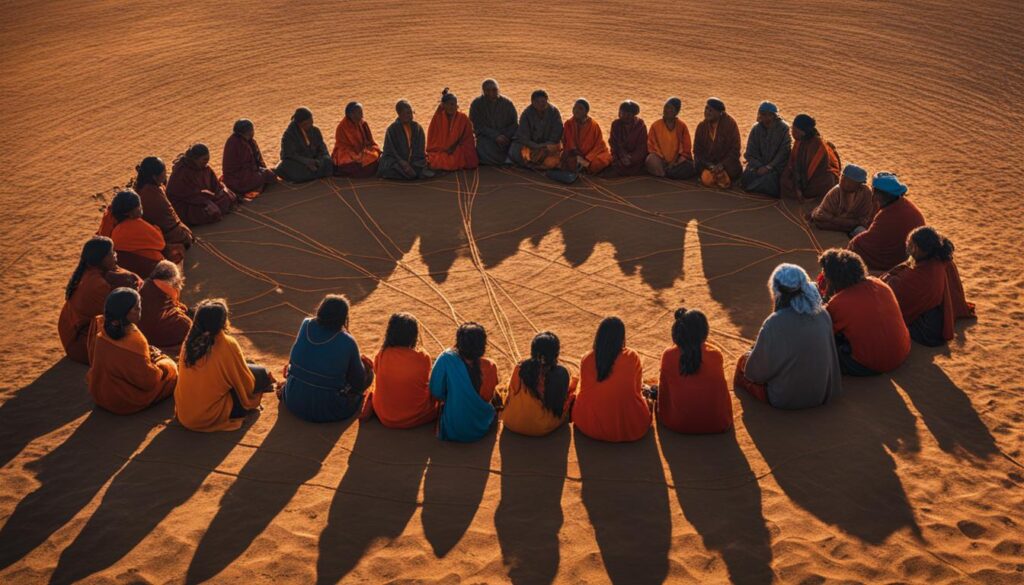
| Kinship Ties | Description |
|---|---|
| Family | Includes immediate and extended family members, creating a web of interconnected relationships within the community. |
| Community | Serves as a support system, providing guidance, mentorship, and a sense of belonging. |
| Tribe | Larger groups within the community that share a common ancestry and cultural heritage, strengthening connections to land and cultural practices. |
| Land | Has spiritual significance and is seen as the provider of life and sustenance. Creates a sense of place, belonging, and responsibility. |
| Relationships | Based on blood, marriage, association, and spiritual significance, forming strong bonds within the community. |
Respect for Elders
In Aboriginal communities, respect for elders is at the core of our cultural values. Elders hold a position of leadership and are revered for their extensive knowledge, deep understanding, and invaluable wisdom of Aboriginal culture. They are the custodians of our traditions and play a pivotal role in guiding and supporting the community.
Elders offer valuable advice and provide a wealth of insight gained through their life experiences and connections to our ancestral heritage. Their wisdom serves as a beacon of light, illuminating the path for younger generations to follow. By respecting and honoring our elders, we ensure the preservation of our cultural identity and strengthen the bonds of our community.
Respecting elders goes beyond mere reverence; it is a demonstration of cultural competence. It involves recognizing the importance of their guidance and the wisdom they impart. This respect extends to valuing their contributions and seeking their guidance in decision-making processes that impact our community.
When we show respect for our elders, we foster a sense of unity and harmony within our community. We acknowledge the intergenerational transfer of knowledge and the profound impact it has on our cultural continuity. By actively listening and learning from our elders, we promote cultural diversity, understanding, and appreciation.
Guiding the Way:
“Our elders are like the roots of a tree, anchoring us to our history, culture, and values. Their wisdom shapes our future and nurtures the growth of our community.” – Aboriginal proverb
As we embrace the wisdom of our elders, we build stronger connections to our heritage and gain a deeper understanding of our place in the world. Their guidance and support enable us to navigate the complexities of life with cultural integrity and resilience.
Respecting our elders is not a one-time action but a continual practice that strengthens our cultural fabric. It fosters a sense of belonging, unity, and respect within the community. By upholding the value of our elders, we preserve the knowledge and traditions that have shaped Aboriginal culture for millennia.
Let us cherish and honor our elders, embracing their teachings and ensuring their voices are heard. Together, we can create a society that values the wisdom, knowledge, and leadership of our Aboriginal elders.
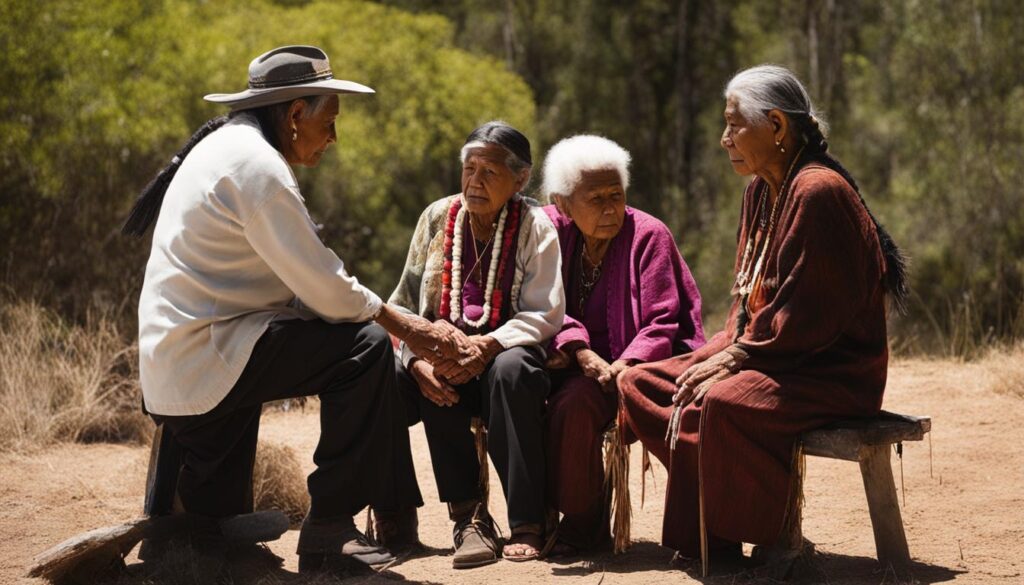
| Benefits | Description |
|---|---|
| Preservation of Cultural Knowledge | Honoring our elders ensures the continuity of Aboriginal traditions, stories, and customs. |
| Community Cohesion | Respecting elders strengthens the bonds within the community, fostering unity and solidarity. |
| Mutual Learning | By listening to our elders, we gain valuable insights and learn from their experiences. |
| Intergenerational Connectivity | Respecting elders nurtures connections between generations, bridging the past, present, and future. |
| Enhanced Cultural Competence | Valuing our elders promotes cultural understanding and sensitivity within society. |
Aboriginal Spiritual Relationship with the Land
Aboriginal people have a profound spiritual relationship with the land, viewing it as their Country and an integral part of their spiritual identity. This connection remains strong, even for those who no longer live on their ancestral lands. Aboriginal spirituality is deeply rooted in the Dreamtime, which encompasses creation stories, cultural lore, and values.
“The land is our mother. We are born from her, and when we die, we return to her. She sustains us, provides for us, and shapes who we are as Aboriginal people.” – Elder from the Yolngu Nation
For Aboriginal people, the land is not just a physical space but a living entity with its own spiritual essence. It is a source of sustenance, a teacher, and a place of belonging. The Dreamtime is a time of creation when the ancestral beings shaped the land, plants, and animals. It holds the cultural connection and sacred knowledge that guides Aboriginal people’s everyday lives.
Aboriginal people have traditionally practiced sustainable land management, understanding the importance of caring for the land to ensure its continued abundance and significance. This spiritual responsibility includes practices such as controlled burning, protecting sacred sites, and preserving biodiversity. By maintaining a harmonious relationship with the land, Aboriginal communities have sustained their cultural heritage for thousands of years.
Through their deep spiritual connection to the land, Aboriginal people have developed a profound respect for nature and sustainable practices. This reverence for the environment is a reminder of the interconnectedness between humans and the natural world. It serves as a powerful example of how cultural preservation and environmental stewardship can go hand in hand.
Preserving Cultural Heritage Through Sustainable Practices
Aboriginal communities continue to prioritize sustainable practices by respecting the land, conserving resources, and passing on traditional knowledge to future generations. This commitment to sustainability not only preserves their cultural identity but also contributes to the broader global effort to protect the environment.
| Sustainable Practices | Benefits |
|---|---|
| Controlled burning | Maintains ecological balance, reduces the risk of wildfires, and promotes the growth of culturally significant plants. |
| Protecting sacred sites | Preserves cultural heritage, biodiversity, and maintains the spiritual connection between Aboriginal people and the land. |
| Preserving biodiversity | Ensures the survival of unique flora and fauna species, maintaining the delicate ecosystem balance. |
| Caring for water sources | Supports sustainable water management practices, ensuring the availability of clean water for Aboriginal communities and the wider ecosystem. |
By valuing the land as a sacred entity and practicing sustainable land management, Aboriginal people exemplify the importance of living in harmony with nature. Their spiritual relationship with the land serves as an inspiration for promoting environmental consciousness and cultural connection in today’s world.
Why is it important to learn about Aboriginal culture?
Learning about Aboriginal culture is crucial for gaining a different perspective, fostering empathy, and building connections. It allows us to develop a deeper understanding of the historical damage caused by colonization and the importance of respect and support for Aboriginal people.
By immersing ourselves in the rich heritage and traditions of Aboriginal culture, we can bridge the gap between different points of view and cultivate a sense of connection with the indigenous communities of Australia. Learning about Aboriginal culture helps us appreciate the resilience and strength of Aboriginal people in the face of historical injustice.
This knowledge equips us with the tools to challenge misconceptions, stereotypes, and biases, promoting a more inclusive and respectful society. It opens our eyes to the diverse customs, languages, and art forms that make up Aboriginal culture, enhancing our cultural competence and enriching our own identity.
Through learning about Aboriginal culture, we become advocates for change, actively supporting the ongoing fight for recognition, justice, and empowerment. By fostering respect and support for Aboriginal people, we contribute to the collective healing of historical wounds and work towards a future that celebrates the diverse cultural tapestry of Australia.
Why does Aboriginal culture matter?
Aboriginal culture holds immense significance in Australia due to its ancient knowledge and practices that promote environmental sustainability. It enriches our society with its diversity, offering deep links to ancient history that connect us to the roots of our land. Aboriginal culture provides unique perspectives on living in this country, nurturing a greater understanding and appreciation of the environment and our place within it.
One of the most striking aspects of Aboriginal culture is the wealth of stories that it encompasses. These stories, passed down through generations, carry profound wisdom and understanding of the world. They offer different views on life, enriching our own perspectives and challenging us to embrace new ways of thinking and being.
Furthermore, Aboriginal culture celebrates societal diversity, recognizing the value of individual and communal identities. Through cultural practices, such as language, ceremonies, storytelling, dance, music, and art, Aboriginal culture fosters a sense of belonging and unity while honoring the unique contributions of each person.
Moreover, Aboriginal culture’s deep connection to the land and its sustainable practices provide invaluable insights into environmental stewardship. Aboriginal people have long understood the delicate balance of nature and have practiced sustainable land management for centuries. Their ancient knowledge offers valuable lessons in resilience and harmonious coexistence with the natural world.
Overall, the significance of Aboriginal culture lies in its ability to bridge the past, present, and future by connecting us to the ancient wisdom and environmental sustainability of our land. By embracing and respecting Aboriginal culture, we nurture a more inclusive and harmonious society that values the diversity of stories, perspectives, and practices that shape our nation.
Where do I start?
Engaging with Aboriginal issues can be a starting point to foster understanding and appreciation of Aboriginal culture. It begins with clearing stereotypes, myths, and unconscious bias that may hinder our ability to form authentic connections. By challenging preconceived notions and expanding our knowledge, we can create a foundation for respectful engagement.
“The first step towards change is awareness. The second step is acceptance.”
– Nathaniel Branden
Understanding the diverse nature of Aboriginal cultures is essential. Aboriginal Australia comprises hundreds of distinct nations, each with its traditions, practices, and languages. Recognizing this diversity allows us to move beyond the notion of a singular Aboriginal culture and appreciate the richness and complexity of Aboriginal heritage.
Choosing respectful language is also crucial when engaging with Aboriginal culture. Language holds immense power and can shape perceptions and attitudes. By using appropriate and inclusive terminology, we demonstrate respect for Aboriginal people and their communities.
Fostering Cultural Awareness
Here are some practical steps to engage with Aboriginal issues and promote cultural awareness:
- Read and educate ourselves: Explore books, articles, and resources that provide insights into the diverse cultures, histories, and experiences of Aboriginal people.
- Listen and learn from Aboriginal voices: Seek out authentic Indigenous voices through literature, podcasts, documentaries, and art to gain a deeper understanding of their perspectives.
- Attend cultural events and activities: Participate in Aboriginal cultural events, ceremonies, art exhibitions, and performances to immerse ourselves in the richness of Aboriginal traditions.
- Engage in respectful dialogue: Initiate conversations and engage with Aboriginal people and communities in a respectful and open-minded manner. Approach conversations with a willingness to listen and learn.
Unleashing the Power of Unconscious bias
Unconscious bias refers to the automatic associations and attitudes that can influence our perceptions and decisions without our conscious awareness. By becoming aware of our biases, we can challenge and overcome them, allowing for a more genuine connection with Aboriginal culture.
- Reflect on personal biases: Take time to reflect on your own beliefs, assumptions, and stereotypes about Aboriginal people and culture.
- Stay open to learning and unlearning: Approach the process of engaging with Aboriginal culture with an open mind. Be willing to unlearn misconceptions and reframe your perspectives.
- Seek diverse perspectives: Actively seek out a variety of perspectives and viewpoints from Aboriginal communities to expand your understanding and challenge any unconscious biases that may emerge.
Respecting the Past, Embracing the Future
Engaging with Aboriginal issues is an ongoing journey guided by respect, empathy, and a commitment to continuous learning. By challenging stereotypes, clearing myths, and addressing unconscious bias, we can create a space for authentic and meaningful engagement with Aboriginal culture. Let’s embark on this journey together, fostering understanding, and celebrating the vibrant tapestry of Aboriginal heritage.
Clearing the Weeds
When it comes to understanding Aboriginal culture, it is important to clear the weeds that hinder our perception. Stereotypes, myths, and unconscious biases can distort our understanding and prevent us from engaging accurately and respectfully. We must recognize the diverse nature of Aboriginal cultures and dispel any misconceptions that may arise.
One common misconception is assuming that there is only one Aboriginal culture. In reality, Australia’s indigenous population comprises diverse Aboriginal cultures, each with its own unique traditions, languages, and customs. Acknowledging this diversity allows us to appreciate the richness and complexity of Aboriginal heritage.
Another misconception to address is the idea that all Aboriginal people have the same skin color. Aboriginal communities encompass a wide range of skin tones, reflecting the diverse ancestry and geographical locations of different groups. Recognizing this diversity is crucial for representing and respecting the experiences and identities of Aboriginal individuals.
“To accurately understand and engage with Aboriginal culture, we must let go of stereotypes, challenge myths, and be aware of our own unconscious biases. This allows for a more accurate and respectful exploration of the diverse Aboriginal cultures and their rich heritage.”
By clearing the weeds of stereotypes, myths, and unconscious bias, we open ourselves up to a more accurate and respectful engagement with Aboriginal culture. Embracing the diversity of Aboriginal cultures and dispelling misconceptions leads to a deeper appreciation and understanding of the traditions, languages, and customs that shape indigenous Australia.
Creating Awareness and Dispelling Myths
To create awareness and dispel myths surrounding Aboriginal culture, it is important to engage in open dialogue and education. By actively seeking knowledge, challenging misconceptions, and approaching Aboriginal culture with respect and humility, we can foster a more inclusive society that celebrates diversity.
- Avoid making assumptions about Aboriginal culture based on stereotypes.
- Listen and learn from diverse Aboriginal voices and experiences.
- Question and examine your own unconscious biases and preconceived notions.
- Engage in cultural competency training and workshops to broaden your understanding.
- Support initiatives and organizations that promote accurate portrayals of Aboriginal culture.
By taking these steps, we contribute to a collective effort in dispelling myths and breaking down barriers that hinder our understanding of Aboriginal culture. We can build a society that appreciates and respects the rich diversity of Aboriginal heritage and traditions.
Putting in the Seeds
When discussing Aboriginal culture, it is crucial to use respectful language and choose appropriate words that reflect our commitment to understanding and appreciating the diversity of Aboriginal cultures. By understanding and employing Aboriginal terminology and acknowledging the unique traditions and practices within each community, we can foster a culturally sensitive dialogue that respects individual and community preferences for self-identification.
Using respectful language is a starting point for building meaningful connections and promoting cultural competence. It demonstrates our commitment to engaging in discussions about Aboriginal culture with sensitivity and respect. By choosing our words thoughtfully, we can create an inclusive environment that values and celebrates the richness of Aboriginal heritage.
| Respectful Language | Inappropriate Language |
|---|---|
| Aboriginal culture | Native culture |
| Traditional practices | Primitive rituals |
| Aboriginal language | Native tongue |
| Cultural heritage | Tribal customs |
| Dreaming stories | Mythical tales |
By using respectful language and appropriate words, we demonstrate our willingness to learn, understand, and appreciate the value of Aboriginal cultures. This fosters an environment of mutual respect and understanding between Indigenous and non-Indigenous Australians, promoting a shared sense of heritage and enriching the fabric of our diverse society.
We must remember that this process of learning and engagement is ongoing. By putting in the seeds of respectful language and acknowledging the diversity of Aboriginal cultures, we can create lasting positive change in our interactions, perceptions, and relationships with Aboriginal communities.
Let it Grow
Allowing our knowledge and understanding of Aboriginal culture to grow requires continuous learning, maintaining awareness of biases, seeking out positive stories, and actively engaging in education. By challenging unconscious bias and embracing new perspectives, we can contribute to positive change and create a more inclusive and culturally aware society.
Continuous learning is key to expanding our knowledge and understanding of Aboriginal culture. It involves making a commitment to ongoing education, seeking out reliable resources, and engaging with Aboriginal communities and individuals to learn directly from their experiences.
Maintaining awareness of biases is crucial in our journey of cultural understanding. We all have unconscious biases that can influence our perceptions and interactions. Recognizing and challenging these biases allows us to approach Aboriginal culture with an open mind and a willingness to learn.
“Education is the most powerful tool we can use to change the world.”
– Nelson Mandela
Seeking out positive stories is a valuable way to counter negative narratives and stereotypes. It allows us to gain a more balanced and accurate understanding of Aboriginal culture, highlighting the richness, diversity, and resilience of Indigenous communities.
Active engagement in education is essential for positive change. This includes supporting initiatives that promote cultural awareness, advocating for inclusive curricula, and fostering respectful dialogue and collaboration between Aboriginal and non-Aboriginal communities.
Let us embrace the opportunity to learn and grow, to challenge our biases, and to actively contribute to positive change. By doing so, we can cultivate a society that values and respects Aboriginal culture, fostering a future of mutual understanding, appreciation, and celebration.
Conclusion
In conclusion, understanding and respecting Aboriginal culture is crucial for fostering cultural competence and promoting appreciation of the diverse traditions and practices that have shaped indigenous Australia. By acknowledging the rich history, deep-rooted traditions, and ongoing resilience of Aboriginal communities, we can build a society that values and respects the rich tapestry of Aboriginal culture and heritage.
Developing a deep understanding of Aboriginal culture allows us to recognize and appreciate the unique perspectives it offers, promoting respect for the experiences, values, and contributions of Aboriginal people. By actively engaging with Aboriginal culture, we can enhance our cultural competence and build meaningful connections based on mutual understanding and respect.
Appreciating the diversity within Aboriginal culture enriches our society and fosters a sense of inclusivity. It encourages us to challenge misconceptions, dispel stereotypes, and embrace the many different traditions, languages, and art forms that contribute to the vibrant tapestry of Aboriginal culture. Embracing this diversity opens up opportunities for appreciation and cross-cultural learning, creating a society that celebrates the strength and beauty of Australia’s Aboriginal heritage.
FAQ
What is the significance of Aboriginal culture?
Aboriginal culture holds immense significance due to its ancient knowledge and practices that promote environmental sustainability. It enriches Australian society with its diversity and offers deep links to ancient history. Aboriginal culture provides unique perspectives on living in this country and encompasses a wealth of stories that carry profound wisdom and understanding.
Why is it important to learn about Aboriginal culture?
Learning about Aboriginal culture is crucial for gaining a different perspective, fostering empathy, and building connections. It allows for a deeper understanding of the historical damage caused by colonization and the importance of respect and support for Aboriginal people. By learning about and acknowledging the rich heritage and traditions of Aboriginal culture, we can contribute to building a more inclusive and respectful Australian society.
What is the history of Aboriginal culture in Australia?
Aboriginal culture is deeply rooted in the history and traditions of the indigenous people of Australia. Before colonization, Aboriginal communities thrived with complex kinship systems, diverse languages, rich cultural practices, and extensive knowledge of the environment. However, the arrival of Europeans led to mass killings, displacement from ancestral lands, cultural suppression, and profound loss. Despite these challenges, Aboriginal communities remain resilient and strive to preserve their culture and traditions.
What are the Stolen Generations?
The Stolen Generations refers to the Aboriginal and Torres Strait Islander children who were forcibly taken from their families and communities through government policies. This resulted in the disruption of cultural, spiritual, and family ties, leaving a lasting impact on the affected individuals and their descendants. In 2008, the Australian Prime Minister delivered a National Apology to The Stolen Generations, acknowledging the past wrongs and advocating for redress and reconciliation.
How is respect for elders important in Aboriginal culture?
In Aboriginal communities, respect for elders is vital. Elders hold a position of leadership and are respected for their knowledge, understanding, and wisdom of Aboriginal culture. They play a crucial role in providing guidance, support, and cultural preservation within the community. Understanding and honoring the importance of respecting elders is essential for cultural competence.
What is the spiritual relationship between the Aboriginal people and the land?
Aboriginal people have a profound spiritual relationship with the land, viewing it as their Country and an integral part of their spiritual identity. This connection remains strong, even for those who no longer live on their ancestral lands. Aboriginal spirituality is deeply rooted in the Dreamtime, which encompasses creation stories, cultural lore, and values. Aboriginal people have traditionally practiced sustainable land management, understanding the importance of caring for the land to ensure its continued abundance and significance.
How can we engage with Aboriginal issues respectfully?
Engaging with Aboriginal issues can start by clearing stereotypes, myths, and unconscious bias. Understanding the diverse nature of Aboriginal cultures and choosing respectful language are essential steps. By becoming aware of and challenging our own biases, we can create a foundation for learning and engaging with Aboriginal culture in a respectful and meaningful way.
What steps can be taken to learn about Aboriginal culture?
Allow your knowledge and understanding of Aboriginal culture to grow by continuously learning, maintaining awareness of biases, seeking out positive stories, and actively engaging in education. By challenging unconscious bias and embracing new perspectives, we can contribute to positive change and create a more inclusive and culturally aware society.
Source Links
- https://vpsc.vic.gov.au/workforce-programs/aboriginal-cultural-capability-toolkit/aboriginal-culture-and-history/
- https://www.creativespirits.info/aboriginalculture/education/how-do-i-start-learning-about-aboriginal-culture
- https://shareourpride.org.au/sections/our-culture/index.html
Mary is a passionate writer who brings creativity and a fresh perspective to our team. Her words have the power to captivate and inspire, making her an essential contributor to our content. Mary’s commitment to storytelling and dedication to promoting Indigenous culture ensures that her work touches the hearts of our readers. We’re fortunate to have her as part of our team.
